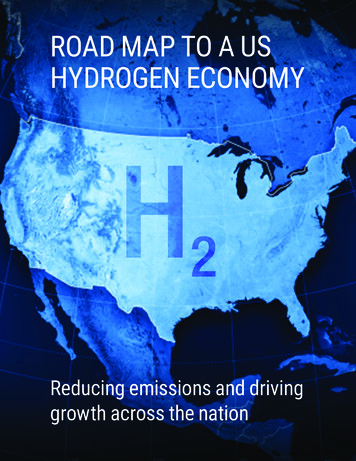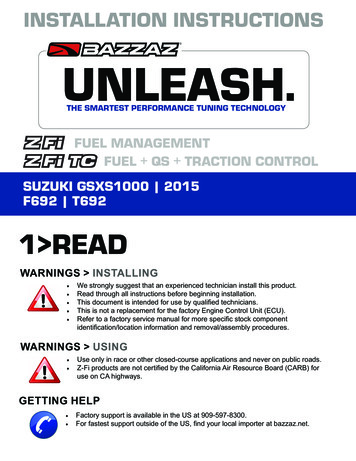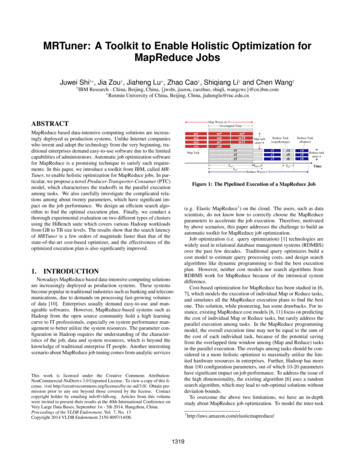
Transcription
ROAD MAP TO A USHYDROGEN ECONOMYReducing emissions and drivinggrowth across the nation
This report was developed with input from 20 companies and organizations: Air LiquideAir ProductsAmerican Honda Motor Co., IncAudiChevronCummins Inc.Daimler AG: Mercedes-BenzFuel Cell GmbH/Mercedes-BenzResearch & DevelopmentNorth AmericaEngieExelon CorporationHyundai Motor Company MicrosoftNikola MotorsNel HydrogenPlug PowerPower InnovationsShellSouthern CaliforniaGas CompanySouthern CompanyServices, Inc.ToyotaXcel EnergyThe authors would like to thank the Fuel Cell & Hydrogen EnergyAssociation for coordinating the group and managing the process, theElectric Power Research Institute for contributing scientific observationsand technical input, and McKinsey & Company for providing analyticalsupport. The authors also wish to acknowledge the US Departmentof Energy’s National Laboratory technical experts Amgad Elgowainyfrom Argonne National Laboratory and Mark Ruth from the NationalRenewable Energy Laboratory for independent analysis and review.Copies of this document can be downloaded from ushydrogenstudy.org.Reproduction is authorized provided the source is acknowledged.
CONTENTSFOREWORD2METHODOLOGY4EXECUTIVE SUMMARY6Vision for a hydrogen economy7Road map to a hydrogen economy13Path forward19VISION FOR A HYDROGEN ECONOMY20Benefits of hydrogen21Applications of hydrogen23Fuel for residential and commercial buildings29Transportation fuel33Feedstock for industry and long-distance transport38Fuel for industry48Power generation and grid balancing50Hydrogen supply and delivery vision54Production55Distribution60Fueling stations61ROAD MAP TO A HYDROGEN ECONOMY632020 to 2022: Immediate next steps652023 to 2025: Early scale-up702026 to 2030: Diversification73After 2030: Broad rollout across the US76PATH FORWARD78APPENDIX81Definitions of hydrogen production pathway examples81Model assumptions82TCO analysis of ICE and FCEV SUVS87ABBREVIATIONS88ENDNOTES89
ROAD MAP TO A US HYDROGEN ECONOMYForeword2FOREWORDThe United States has long been a leader in global energy innovationand has led the world in the production and distribution of gaseousand liquid hydrogen. The shift to broader use of hydrogen offersan opportunity to extend that leadership.Fuel cell technologies and hydrogenenergy are being commercializedin the US and abroad. Governmentsin Asia and the European Union, incoordination with industry, are nowinvesting more than 2 billion everyyear in hydrogen as a promisingenergy carrier.The US is among the leadingcountries in moving towards broadcommercialization of fuel cells andihydrogen energy. With over 7,600fuel cell electric vehicles (FCEVs)currently on the road – more thanany other country – the US is hometo more than half of the global FCEViistock. In addition, the US is a globalleader in the development of fuelcell applications that competewith incumbent technologies. Forexample, more than 25,000 fuelcell–powered material handlingproducts, such as forklifts, areoperating in warehouses anddistribution facilities acrossthe country. There are over8,000 small-scale fuel cell systemsoperating across 40 states,primarily for cell phone towers andremote communications networks.In total, there are over 550 MWof installed or planned fuel cellsfor large-scale stationary powerfor backup power, critical loads,and combined heating and poweriiiapplications. The US is home toseveral leading fuel cell, electrolyzer,and hydrogen component andsystem manufacturers as wellas large multinational hydrogencompanies with liquid andcompressed hydrogen productionand distribution equipment.Hydrogen as a vehicle fuel can beused for the transport of goodsand people. It can serve to storeenergy from nuclear and renewablesources and distribute it acrosssectors. Hydrogen and fuel celltechnologies have great potential toprovide low-carbon heat and reliablepower for communities and criticalfacilities. Hydrogen is also a growingfuel and feedstock for industrialand agricultural processes, andmuch more. The smooth transitionto a broader use of hydrogen canprovide significant economic,social, and environmental benefitsto the US. While hydrogen hasa strong technical foundation,positioning it as the energy carrierof choice and creating a vibrant,competitive hydrogen economy willalso require a foundation of financialand policy support.
ROAD MAP TO A US HYDROGEN ECONOMYForewordThis US Hydrogen Road Map wascreated through the collaborationof executives and technical industryexperts in hydrogen across a broadrange of applications and sectors,who are committed to improvingthe understanding of hydrogen andhow to increase its adoption acrossmany sectors of the economy.For the first time, this coalition ofindustry leaders has convenedto develop a targeted, holisticapproach for expanding the use ofhydrogen as an energy carrier.seasonal weather-related issues,such as high temperatures orwildfire-related power interruptions.Some states have emphasizedthe need to decarbonize the gasgrid, so blending hydrogen in naturalgas networks and using hydrogenas feedstock may advance morequickly in these regions. Otherstates are interested in hydrogenas a means to address power gridissues, enable the deploymentof renewables, and supportcompetitive nuclear power. Thelaunch of hydrogen technologiesin some states or regions willhelp to scale hydrogen in variousapplications across the country,laying the foundation for energysecurity, grid resiliency, economicgrowth, and the reduction of bothgreenhouse gas (GHG) emissionsand air pollutants.Due to great variation amongnational and state policies,infrastructure needs, andcommunity interests, each stateand region of the US will likely haveits own specific policies and roadmaps for implementing hydrogeninfrastructure. The West Coast,for example, has traditionally hadprogressive policies on reducingtransportation emissions, so itis likely that hydrogen will scalesooner for vehicles in this region,especially California. Experts alsoacknowledge the role that hydrogenin combination with renewablescan play in supplying microgridtype power to communities withthe highest risk of shut-offs during3This report outlines the benefitsand impact of fuel cell technologiesand hydrogen as a viable solutionto the energy challenges facingthe US through 2030 and beyond.As such, it can serve as the latestcomprehensive, industry-driven,national road map to accelerate andscale up hydrogen in the economyacross North America.
ROAD MAP TO A US HYDROGEN ECONOMYMethodology4METHODOLOGYThis report describes an ambitious pathwayfor hydrogen in the US.The ambitious scenario assumeshydrogen is championed asan economic growth driver,a leadership opportunity for USbusinesses, and as a tool forsignificant decarbonization inthe US. This scenario assumesfederal regulation and policiesto require emissions reductionacross industries and acrossthe country. This scenario alsoassumes state and regionalsupport for low-carbon initiativesand collaborative partnershipswith key stakeholders to resolvethe challenges in scaling hydrogen.It assumes US businesseschampion hydrogen as a growingglobal business opportunity,a means to take carbon out oftheir operations, or a competitivenew source of locally producedenergy. This scenario is reflectedin the calculations for this report,with a view of how the US couldimplement the shift to a hydrogeneconomy over time. This scenariois, by definition, an optimisticand aggressive growth scenariofor hydrogen – representinga starkly different trajectoryfrom the one we are on today.The base scenario assumes the USdoes not take strong measures tosupport the growth of hydrogen.At the federal level, it assumesnegligible or nonexistent climatepolicy (such as carbon pricing), aswell as negligible policy supportfor hydrogen. At the state level, itassumes those states that alreadyhave aggressive decarbonizationtargets pursue hydrogen asa means to reduce emissions.In the base scenario, annualhydrogen demand does not scalesignificantly from today’s levels.Hydrogen demand would reach14 million metric tons by 2030 and20 million metric tons by 2050,representing 1 percent of US finalenergy demand. Hydrogen’s mainuse would remain as a feedstockin industrial processes, withsome uptake of hydrogen astransportation fuel in buses, trucksand forklifts. The base scenariois not the focus of this report.The hydrogen molecule is a zerocarbon energy carrier in that it doesnot contain carbon. Furthermore,the conversion of hydrogen into otherforms of energy through combustionor the use of a fuel cell does notdirectly result in the production of CO2.
ROAD MAP TO A US HYDROGEN ECONOMYMethodologyHowever, overall energy conversionsto generate hydrogen may emitCO2 or other GHG. Throughoutthis report, the term “low-carbonhydrogen” is used to differentiatefrom traditional, industrial hydrogenproduced from natural gas withoutcarbon capture. It refers to hydrogenproduced with a limited level of net1GHG emissions from reformerbased hydrogen with carbon captureand storage (CCS) technologies,2from renewable natural gas (RNG)feedstock, from water electrolysisusing low-carbon electricity,through direct gasification ofwaste including municipal andagricultural, as well as by-producthydrogen recovered from otherindustrial processes. Low-carbonhydrogen includes both renewablehydrogen (i.e., hydrogen producedfrom renewable energy sources)and non-renewable hydrogen.Low-carbon electricity refersto electricity generated fromlow-carbon sources, includingsolar, wind, hydro, tidal, nuclear,geothermal, RNG, and traditionalthermal power with CCS. Renewableelectricity refers to electricitygenerated from non-fossilsources, namely wind, solar (solarthermal and solar photovoltaic),and geothermal energy, tidal,wave, and other ocean energy,hydropower, biomass, landfillgas, sewage treatment plant gas,and other forms of biogas.12Several regulatory bodies and organizations are working to define standards and terminology for the various low-carbon productionpathways, such as the European 2016 CertifHy definition and the California CARB LCFS policy usage. See appendix for more details.A methane-rich gas obtained from bio- and waste-based sources that can be a direct replacement for natural gas in many processes.5
ROAD MAP TO A US HYDROGEN ECONOMYExecutive summary6EXECUTIVESUMMARYFifty years ago, the US put the firstman on the moon. The Apollo 11mission relied on a hydrogen-poweredfuel cell system, which suppliedelectricity and water for the mission,and on liquid hydrogen as fuel topropel the rockets. Since 1969,America has remained a leader infuel cell and hydrogen technology,commercializing a wide rangeof technologies that produce,deliver, store, and utilize hydrogenacross applications and sectors.Today, the hydrogen industry aswell as the US are at a crossroadsas the country’s energy futureis determined.The energy system across the USis evolving. From power generationto transportation, new technologiesare gaining share. Companies aregrappling with decarbonization,preservation of natural resources,aging infrastructure, energystorage, an evolving regulatorylandscape, and new customerdemands. The resiliency andreliability of our energy system aregrowing concerns.Hydrogen is key to overcomingthese challenges. Hydrogen isan energy carrier that cuts acrosssectors and has multiple benefits.It can be used to store energy overlong periods of time and transportenergy over large geographies.FCEVs, whether heavy-duty, lightduty, or material-handling vehicles,produce no tailpipe emissions,and hydrogen can be producedwith near-zero carbon emitted,even on a lifecycle basis. A vibranthydrogen industry would maintainUS energy leadership and security,create jobs, significantly reducecarbon emissions, and supporteconomic growth.The time to boost support forhydrogen is now. Decisions andinvestments made now will havelong-term impact. Moreover, manyenergy infrastructure decisionstake a long time to implement.Other countries are laying plansfor hydrogen economies, andthe US will need to move quicklyto continue to lead in this growingindustry. US Department of Energyfunding for hydrogen and fuel cellshas ranged from approximately 100 million to 280 million peryear over the last decade, withapproximately 150 million per yearivsince 2017. Other countries arealso investing heavily in hydrogen.For example, Japan’s Ministry ofEconomy, Trade, and Industry hasannounced hydrogen funding ofvapproximately 560 million for 2019.China has announced hydrogentransport industry investments ofmore than 17 billion through 2023.In Europe, Germany’s investmentincludes 110 million annually tofund research laboratories to testnew hydrogen technologies forviindustrial-scale applications.Investment is needed to laythe groundwork for hydrogensolutions. Capital is requiredto build foundational hydrogeninfrastructure and companiesneed the right incentives toinvest in low-carbon hydrogensolutions. Regulatory barriers andappropriate codes and standardsneed to be addressed to enablelarge-scale commercializationand a robust, reliable supplychain. Funding is required formore research, development,demonstration, and deployment forhydrogen technologies, to improvecompetitiveness and performance.Directing capital to hydrogen is key toenabling its growth in the US.
ROAD MAP TO A US HYDROGEN ECONOMYExecutive summary7Vision for a hydrogeneconomyHydrogen is critical for a lowercarbon energy mix. It can be usedbroadly across several industries,including for transport, steel,ammonia, methanol, refining,in residential and commercialbuildings, and in the power system.By our modeling estimates,hydrogen can help meet 14 percentof US final energy demand by 2050,the equivalent of over 2,468 TWh or38.4 billion MMBTU per year.A competitive hydrogen industrywill reinforce US energy leadership.The US is now the world’s largestproducer of natural gas and oil,exporting to more than 35 countries.As countries around the worldlook to hydrogen to reduce carbonemissions, the US has an opportunityto reinforce and grow its energyleadership position and createjobs in this field. The competitivedomestic supply of hydrogen willenable exports of the fuel to othermarkets that do not have suchcompetitive supplies.A robust hydrogen industry willstrengthen the US economy. Thisgrowing industry creates jobs forUS citizens and revenues for USbusinesses. These businessesoperating in the hydrogen value chainwill also grow by exporting technology3, 3to regions looking to develop theirhydrogen infrastructure, such asEurope, China, Japan, Korea, andAustralia. By 2030, the hydrogeneconomy in the US could generatean estimated 140 billion per year inrevenue and support 700,000 totaljobs across the hydrogen valuechain. By 2050, it could drive growthby generating about 750 billion peryear in revenue and a cumulative43.4 million jobs (Exhibit 1).By utilizing domestic energyresources and increasing energyresiliency, hydrogen will help topreserve our national energysecurity. Hydrogen productionwould use abundant renewableresources, natural gas, and carbonstorage, and enable a competitivenuclear industry. Long-term energystorage with hydrogen will maximizerenewable energy productionand use, further enhancing totaldomestic energy production and use.It would allow abundant domesticnatural gas to continue to provideaffordable energy to meet demand,even in a decarbonized scenario, withthe application of carbon capture.that are difficult to decarbonize,such as long-distance roadtransport and high-grade heat.Besides lower carbon emissions,hydrogen used as vehicle fuelcompletely eliminates emissionsof tailpipe particulates, nitrogenoxides (NOx), and sulfur oxides (SOx),improving regional air quality whilereducing greenhouse gas emissions(GHG) emissions.Hydrogen enables betterintegration of low-carbon electricpower resources. Grid-connectedelectrolyzers that produce hydrogencould provide a significant sourceof flexibility for intermittentrenewables, providing longduration storage solutions that arecomplementary to short-durationbattery solutions. In addition, theycan provide additional load forlow-carbon power sources likerenewable and nuclear power.Hydrogen is a unique energycarrier with applicationsacross sectorsHydrogen can be used:Hydrogen has significantenvironmental and health benefits.Hydrogen is an especially valuablesolution for energy needs in areasIn buildings. An estimated47 percent of US homes currentlyviihave natural gas space heating,This ambitious scenario refers to the long-term potential of hydrogen in the US and is based on input from industry on achievabledeployment by 2030 and 2050. For details about the baseline and adoption rates, please refer to the methodology chapter andthe appendix.
ROAD MAP TO A US HYDROGEN ECONOMYExecutive summary8Exhibit 1Potential benefits of hydrogen in the US in the ambitious scenario – by the numbersHydrogen in the US could Strengthenthe US economy,supporting up to:Create a highlycompetitive sourceof domesticallyproduced lowemission energy 140 bn 100%in revenuedomesticallyproducedProvide significantenvironmentalbenefits andimprove air qualityLessCO2, NOx, SOx, andparticulate emissionsin cities0.7 mjobs in 2030 750 bn 100%-16%3.4 m-36%in revenuejobsBenefit the USenergy systemdomesticallyproducedCO2 14%of final energydemandNOx in 2050Note: Final energy demand excluding feedstock; share of abated CO2 emissions relative to US emissions in 2050 as forecasted in the IEAReference Technology Scenario; for NOx tailpipe emissions only, based on EPA current NOx emissions
ROAD MAP TO A US HYDROGEN ECONOMYExecutive summaryand another 3 to 8 percent(depending on region) use liquifiedviiipetroleum gas (LPG) heating.Replacing or blending some naturalgas with low-carbon hydrogenwould lower GHG emissionsof residential, commercial, andindustrial heating, without newinfrastructure deployment. This canbe achieved by blending hydrogeninto the natural gas grid or deployingstationary fuel cells directly inbuildings to generate electricity anduse the heat they produce in lieu oftraditional space and water heaters.feedstock in industrial processes suchas steelmaking, chemical production,and refining, or as a heating source toreplace fossil fuels. In steelmaking,for example, hydrogen can workas a reductant, substituting coal ornatural gas. Other heavy industrialsectors like ammonia, methanol, andrefining already use large quantitiesof traditional hydrogen (synthesizedfrom natural gas) and would need totransition to low-carbon hydrogen toreduce their emissions.In transport. Transport accounts forixa third of US carbon emissions anddirectly affects air quality in cities.FCEVs and battery-electric vehicles(BEVs) are the only zero-emissionsvehicle (ZEV) solutions to reduceemissions for light-duty, heavy-duty,and material-handling vehicles. Withfueling times similar to conventionalgasoline or diesel vehicles, and withlarger on-board energy storagecapacity than BEVs, FCEVs area natural complementary ZEVtechnology for the transport sectorto transition to zero carbon. Thismakes light-duty and heavy-dutyFCEVs a familiar and competitivemobility solution for customers whowant the capability to refuel quickly,drive long distances, carry heavyloads, or have high uptime. On a totalcost of ownership (TCO) basis,FCEVs could break even between2025 and 2030 with the cost ofinternal combustion engine (ICE)vehicles in applications requiringhigh uptime and fast fueling, andthey already cost less than BEVsas forklifts and in fast chargeapplications above 60 kW.In industrial processes. Industryaccounts for about 20 percent ofxUS carbon emissions. The hardto-decarbonize industrial sectorscan use low-carbon hydrogen asAs backup power or off-gridpower. Through stationary fuelcells, hydrogen provides clean,noiseless, and odorless power. Itprovides backup power for datacenters, hospitals, and other criticalinfrastructure, as well as off-gridpower on military bases and in otherremote facilities with fast ramp-upor ramp-down capabilities. The useof hydrogen fuel cells instead ofdiesel generators in data centersappears on track to achieve costparity in three to five years and hasadditional advantages, such asreduced clean-air permit constraintsand increased operationalxiflexibility. It also has the potentialto offer services back to the electricgrid in the forms of energy storageand peaking capacity.In the power system. Gridconnected hydrogen productioncould support the deployment ofvariable renewables, by providingdemand flexibility to the system.Electrolyzers have the ability toflex up and down to help matchthe variable and intermittentsupply profile of wind or solarenergy. This improves the case forrenewables, as it partially offsetsthe intermittency problems onthe supply side. Where required,stored hydrogen can also beconverted back into power via fuelcells or using hydrogen-ready gas9turbines (at a new or retrofittedpower station). In this way,hydrogen can provide a longterm, high-capacity electricitystorage mechanism.In the ambitious scenario,hydrogen demand potential acrossall these applications could reach17 million metric tons by 2030 and63 million metric tons by 2050.This demand would be primarilydriven by the use of hydrogenas a transportation fuel, as fuelfor residential and commercialbuildings, and as feedstock inindustrial processes like ammoniaand methanol production, andrefining (Exhibit 2 and Exhibit 3).
ROAD MAP TO A US HYDROGEN ECONOMYExecutive summary10Exhibit 2Hydrogen demand potential across sectors – 2030 and 2050 visionMillion metric tons per year11Additional upside from other uses:1 Synthetic jet fuel Ammonia as fuel for shipping63172New feedstock4Power generation and grid balancing5Fuel for industry8Fuel for residential and commercial buildings27Transportation fuel1616Existing feedstock1%14%20131410100%13130.1%1%Base Ambitious20152030H2 share of final energy demand2Base Ambitious2050Assuming that 20% of jet fuel demand would be met by synthetic fuel and 20% of marine bunker fuel by ammoniaDemand excluding feedstock, based on IEA final energy demand for the USNote: Some numbers may not add up due to rounding12
ROAD MAP TO A US HYDROGEN ECONOMYThe US is uniquelypositioned to build a worldleading hydrogen economyThe US has the abundant, low-costprimary energy sources needed toproduce low-carbon hydrogen. Forelectrolytic hydrogen, the country hasample renewable and low-carbonelectricity resources, including wind,solar, hydropower, and nuclear.The US is developing large-scalerenewable power, with forecasts forthe costs of electricity productionxiias low as 20 per MWh in 2030.Furthermore, a national portfolioof small, modular nuclear reactorsto replace the current aging fleet ofconventional reactors beginning inthe 2030s could produce significanthydrogen at a stable cost and witha high capacity factor.For hydrogen produced via naturalgas reforming with carbon captureand storage (CCS), the US hasabundant low-cost natural gasand carbon storage capacity. Thecountry’s natural gas reservesxiiihave prices as low as 2 to 3 perMMBTU. The US has the potentialto store as much as 3,000 metric5gigatons of CO2 in technicallyaccessible storage capacity, thatmay be tapped pending publicxivacceptance of the technology.Utilizing all forms of domestic energyfor hydrogen generation increasesenergy security by decreasingenergy imports. Hydrogen can beflexibly generated, which offersconsumers the lowest cost ofmultiple energy sources at anygiven time and will create economicgrowth across the US, includingin regions that are traditionally notenergy producers. Furthermore,this flexibility of hydrogen increases5Executive summarythe resilience and reliabilityof the entire US energy system.The US is home to industrialsector leaders capable ofscaling a hydrogen economy.US industrial leaders, such asin the petroleum refining andadvanced manufacturing industries,have decades of experiencefinancing and managing capitalintensive megaprojects. Withthe right regulatory support, UScompanies could mobilize largeprivate investments in hydrogenequipment development, hydrogenproduction, and distributioninfrastructure. A large network ofUS companies with expertise infuel cells, electrolyzers, reformers,and CCS are already helping tobring equipment and productioncosts down.For US transport, hydrogen isa strong low-carbon alternative.The US has a large long-haultrucking industry compared withother markets, with about 180 billionxvmiles travelled per year. Onaverage, Americans drive morexvithan 12,000 miles per year pervehicle – nearly twice as far aspeople in other developed countries.Buyers’ vehicle choices reflect thisneed for long-distance capability,as sport utility vehicles (SUVs) andcrossover vehicles have a projectedsales growth of 1 percent per yearin the next decade, while a 1 percentdecline is projected for passengerxviicars. Such long distances andpreferences for large vehicles favorFCEVs over BEVs.Equivalent to 600 years of current total US CO 2 emissions.11
ROAD MAP TO A US HYDROGEN ECONOMYExecutive summary12Exhibit 3There are already many industrial applications in motion that are short-term movesBubble size in the legend corresponds to1 million metric tons of hydrogenPotential hydrogen demand market size in 2030Potential hydrogen demand market size in 2050Established andemergingDistributed powerForklifts/material handlingTrucks (vans/light commercial vehicles, medium- and heavy-duty trucks,captive trucks in ports and mines)Light-duty passenger vehicles (all passenger cars including taxis, pickuptrucks, SUVs, crossovers)Existing feedstockShort-termdecarbonizationmovesSteel (virgin steel only)Aviation (low-carbon fuels)High-grade industrial heatResidential and commercial buildingsLong-termdecarbonizationmovesMedium- and low-grade industrial heatCentralized power
ROAD MAP TO A US HYDROGEN ECONOMYExecutive summary13Road map to a hydrogeneconomyThe full benefits ofhydrogen and fuelcell technologies playout when deployedat scale and acrossmultiple applicationsHydrogen is at a turning point andwill benefit from economies ofscale as it ramps up across statesand sectors in what is known assector coupling. Sector couplingrefers to “the idea of interconnecting(integrating) the energy-consumingsectors – buildings (heating andcooling), transport, and industry –xviiiwith the power-producing sector”in order to provide grid-balancingservices to the power sector,including supply-side integrationfocused on the integration ofthe power and gas sectors forreliability and resiliency. Whendeployed across multipleapplications, systemic benefitsstart to kick in: infrastructure costsare shared across applications,technological developments in oneapplication can be applied to others,and sector-coupling benefits playa meaningful role.In this report, we describe a roadmap for transitioning to a hydrogeneconomy in which hydrogenbecomes a mainstream fuel option.The road map was developed toput forward a concrete proposal forvarious sectors and applicationsthat may be developed and deployedin the coming years. It providesmilestones for deployment andleverages domestic strengths todeliver on the vision set out in the firsthalf of this report. This report aimsto serve as a reference document for6policymakers and industry (Exhibit4 and Exhibit 5).The road map is organized intofour key phases: 2020 to 2022,2023 to 2025, 2026 to 2030, andpost-2030. Each phase has specificmilestones for the deploymentof hydrogen across applications.Each phase also describes the keyenablers required, categorized as(i) policy enablers and (ii) hydrogensupply and end-use equipmentenablers. Policy enablers areneeded initially to create the rightincentives to enable the privatesector to invest in and developthe hydrogen market.The supply of hydrogen scalesup and shifts to low-carbontechnologies. Hydrogen is currentlyproduced mainly from natural gaswithout CCS, which could deliver 40 to50 percent lower GHG emissionsthan gasoline ICEs and zero tailpipexixemissions for light-duty FCEVs.New low-carbon hydrogen productionpathways using natural-gasreforming techniques exist, such assteam methane reforming (SMR)and autothermal reforming (ATR)with CCS or with renewable natural6gas (RNG). Likewise, players canscale up existing water electrolysiswith low-carbon electricity,including renewables. As theseproduction pathways grow, costswill decline significantly.A methane-rich gas obtained from bio- and waste-based sources that can be a direct replacement for natural gas in many processes.
ROAD MAP TO A US HYDROGEN ECONOMYExecutive summary14Exhibit 4Hydrogen enablers road map2020–20222023–20252026–20302031 and beyondImmediate next stepsEarly scale-upDiversificationBroad rolloutTransition of policyincentives in fast-followingmarkets from directsupport to scalablemarket-basedmechanismsReduced/no direct policysupport in certainapplications when reachingcost parityPolicy supportDependable, technology-neutral Policy incentives (state anddecarbonization goals in morefederal) in early markets tostates and at the federal leveltransition from directsupport to scalable marketPublic incentives to bridgebased mechanismsbarriers to initial marketlaunches, bring a wider range of Spread public incentivesmature hydrogen solutions tobridging barriers to initialmarket, increase publicmarket launches beyondpioneer statesawareness and acceptance,and continue to pilot hydrogenRegulatory framework foruse across applicationswider implementation of H2energy storageHydrogen codes and safetystandards, including blendingImplementation of crossstandards, in certain US statessectoral decarbonizationpolicy initiatives to supportPolicy/regulatory framework toinclude grid stability mechanisms distributed energy resourcesfor long-duration energy storage,inclu
This report outlines the benefits and impact of fuel cell technologies and hydrogen as a viable solution to the energy challenges facing the US through 2030 and beyond. As such, it can serve as the latest comprehensive, industry-driven, national road map to accelerate and scale up hydrogen in the economy across North America.











